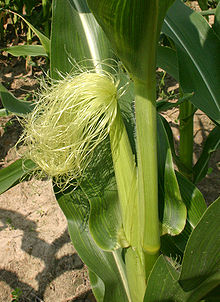柱头 (花)
外观



柱头(英语:stigma)位于花的心皮(或多个心皮愈合)的顶端,以花柱连接子房。传粉时花粉落到柱头上,并萌发出花粉管以到达胚珠。柱头通常具有粘性,并演化出各种不同有利于接受花粉的形式[1],花粉可能透过风传递到柱头(风媒传粉),也可能透过动物或水流。
柱头的外形变异很大,有细长型或圆形,并可能具有毛。当花粉离开花药时,通常是呈脱水状态,抵达柱头后柱头有助花粉湿润并萌发花粉管[2]。柱头可以确保萌发的花粉属于同种植物,还可以执行孢子体自交不亲和性,避免基因型太接近的花粉萌发出花粉管,以芸薹属植物为例,花粉壁具有S基因的产物SCR[3][4] (皆为富含半胱胺酸的蛋白质),S基因可能具有高达百种基因型,彼此间有渐进的显隐性关系。柱头则具有称为SRK的膜蛋白,在胞内有激酶的活性区域[5][6],不同种SRK是不同种SCR的受体。另外柱头还产生一种称为SLG的蛋白质,该蛋白与SRK序列类似,可能是SCR的共同受器,用以增强讯号[7]当SRK与SCR配对时,会使SRK的激酶区域自体磷酸化,并经过尚不清楚的下游途径传递讯息,阻止花粉管萌发[8]。
参考资料
[编辑]- ^ The Penguin Dictionary of Botany, edited by Elizabeth Toothill, Penguin Books 1984 ISBN 0-14-051126-1
- ^ Anna F. Edlund, Robert Swanson and Daphne Preuss. Pollen and stigma structure and function: the role of diversity in pollination. Plant Cell. 2004, 16 (Supplement): 84–97 [2015-01-21]. doi:10.1105/tpc.015800. (原始内容存档于2020-09-30).
- ^ Schopfer, C. R., M. E. Nasrallah, and J. B. Nasrallah. The male determinant of self-incompatibility in Brassica. Science. 1999, 286 (5445): 1697–1700. PMID 10576728. doi:10.1126/science.286.5445.1697.
- ^ Takayama, S., H. Shiba, M. Iwano, H. Shimosato, F.-S. Che, N. Kai, M. Watanabe, G. Suzuki, K. Hinata, and A. Isogai. The pollen determinant of self-incompatibility in Brassica campestris. Proc. Natl. Acad. Sci. U.S.A. 2000, 97 (4): 1920–5. PMC 26537
 . PMID 10677556. doi:10.1073/pnas.040556397.
. PMID 10677556. doi:10.1073/pnas.040556397.
- ^ Stein, J. C., B. Howlett, D. C. Boyes, M. E. Nasrallah, and J. B. Nasrallah. Molecular cloning of a putative receptor protein kinase gene encoded at the self-incompatibility locus of Brassica oleracea. Proc. Natl. Acad. Sci. U.S.A. 1991, 88 (19): 8816–20. PMC 52601
 . PMID 1681543. doi:10.1073/pnas.88.19.8816.: .
. PMID 1681543. doi:10.1073/pnas.88.19.8816.: .
- ^ Nasrallah, J. B., and M. E. Nasrallah. Pollen–stigma signalling in the sporophytic self-incompatibility response. Pl. Cell. 1993, 5: 1325–35. doi:10.2307/3869785.
- ^ Takasaki, T., K. Hatakeyama, G. Suzuki, M. Watanabe, A. Isogai, and K. Hinata. The S receptor kinase determines self-incompatibility in Brassica stigma. Nature. 2000, 403 (6772): 913–6. PMID 10706292. doi:10.1038/35002628.
- ^ Schopfer, C. R., and J. B. Nasrallah. Self-incompatibility. Prospects for a novel putative peptide-signaling molecule. Pl. Physiol. 2000, 124 (3): 935–9. doi:10.1104/pp.124.3.935.
